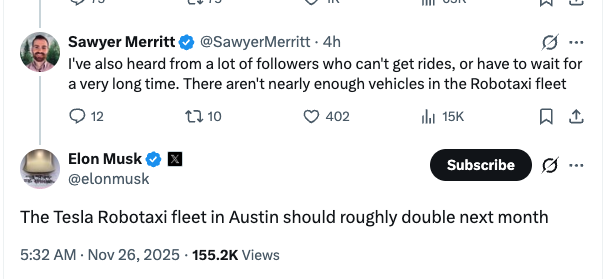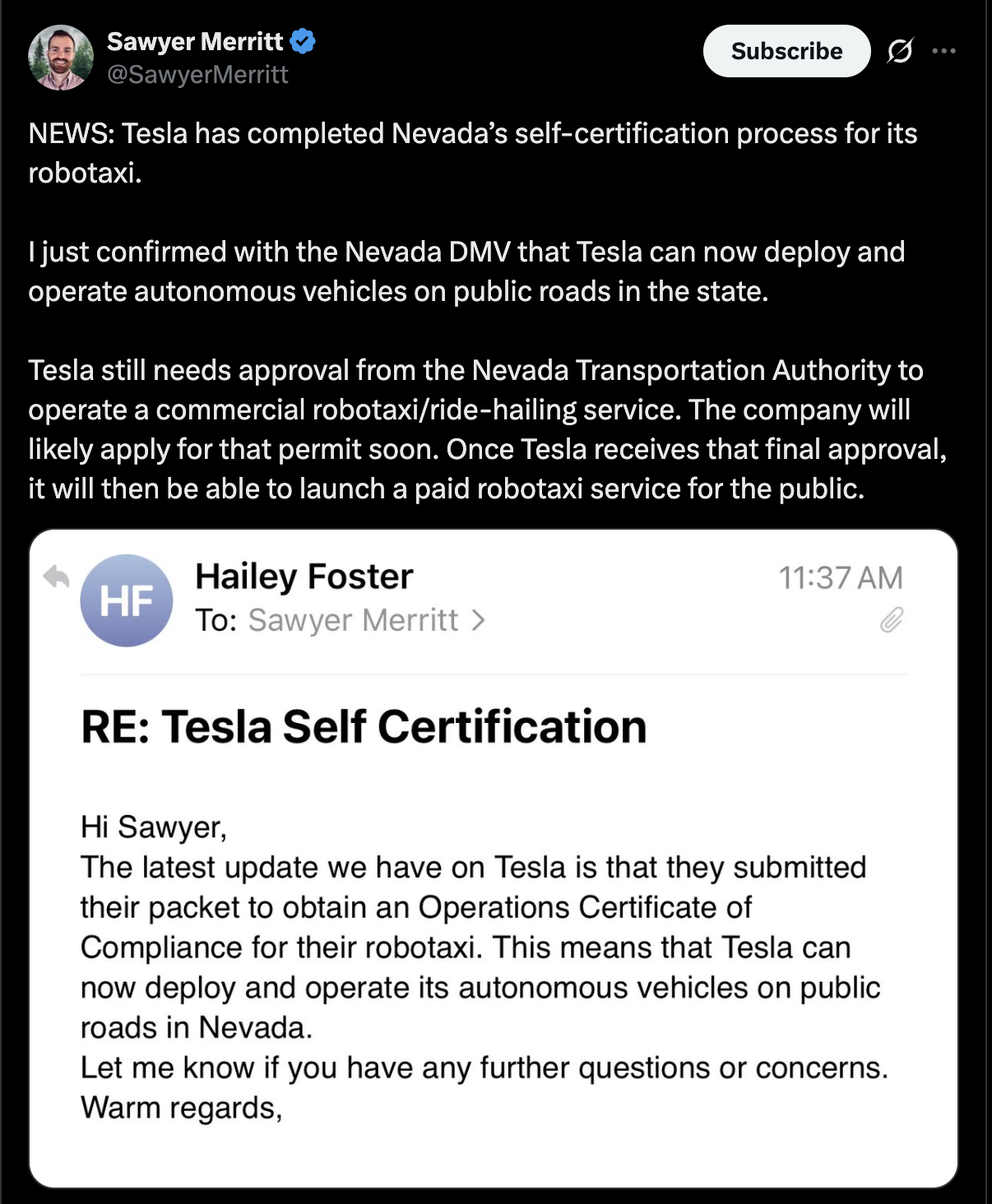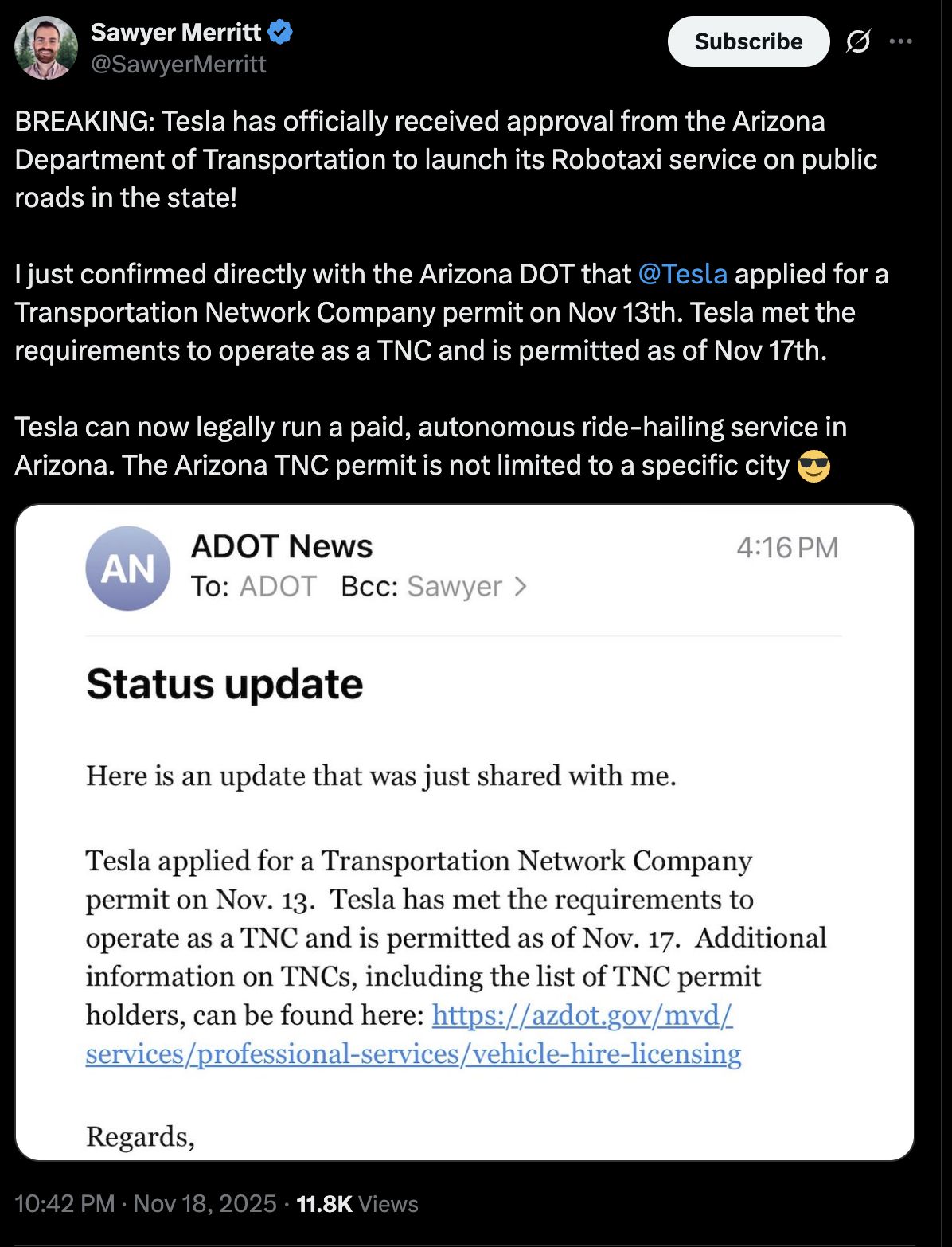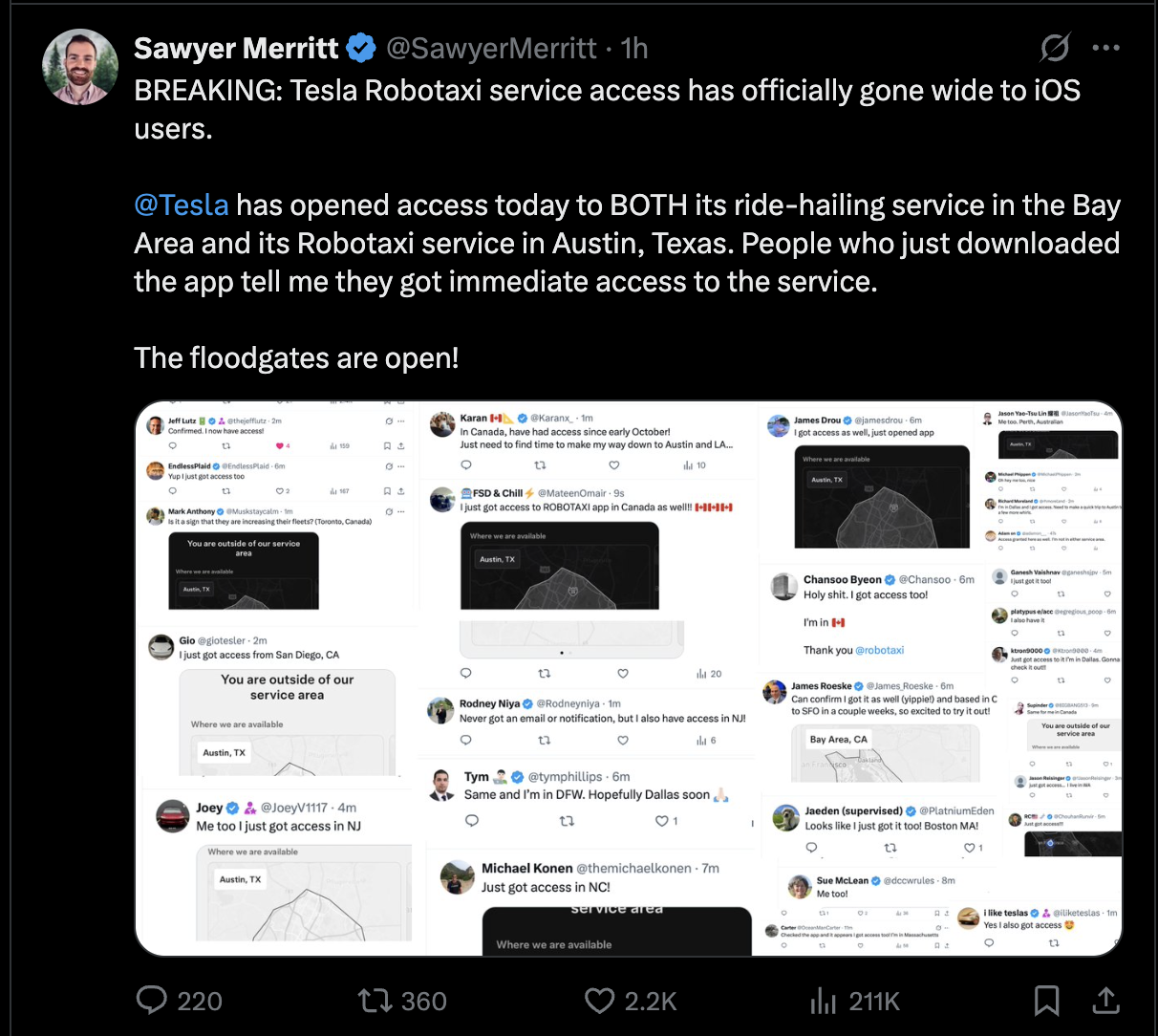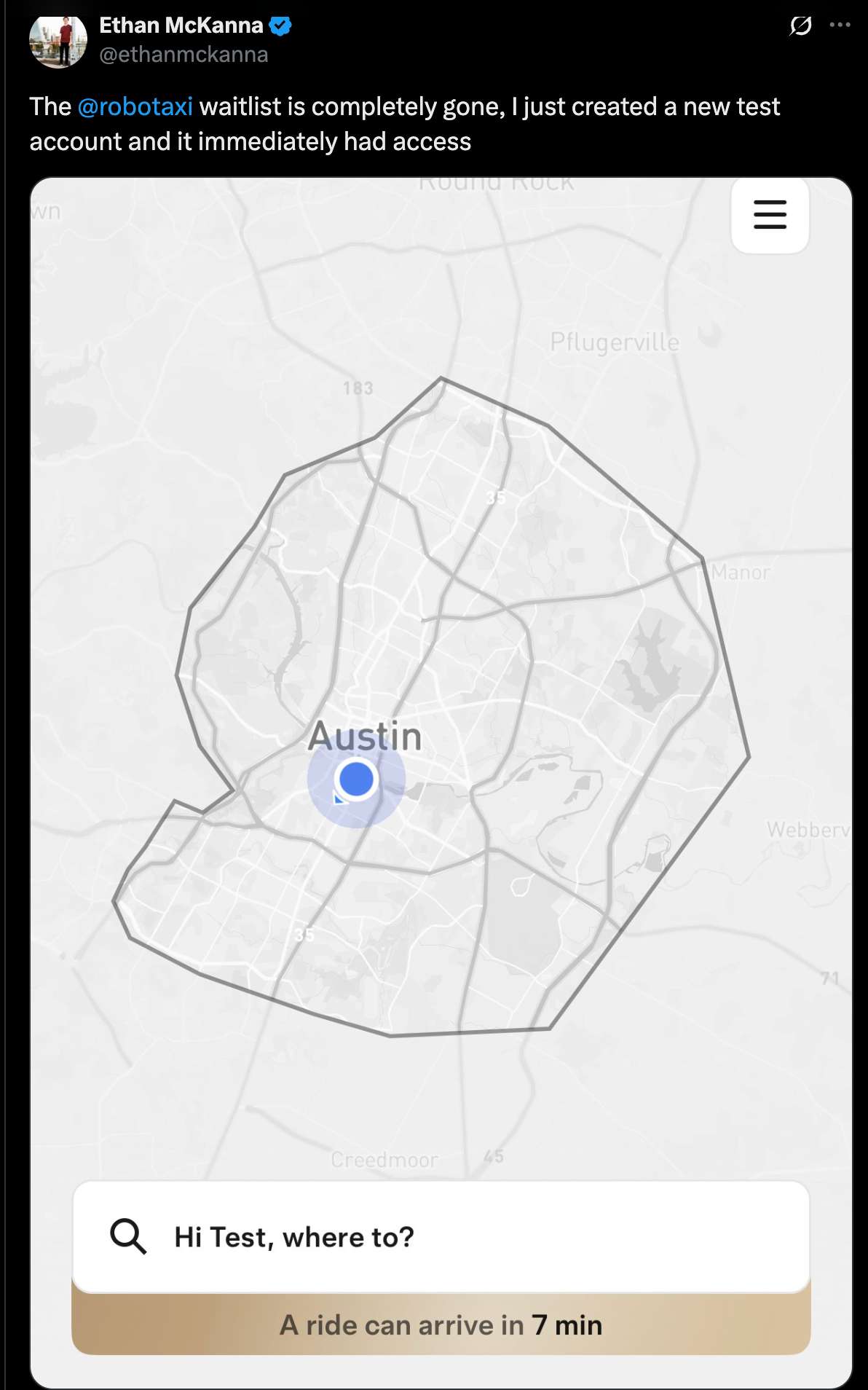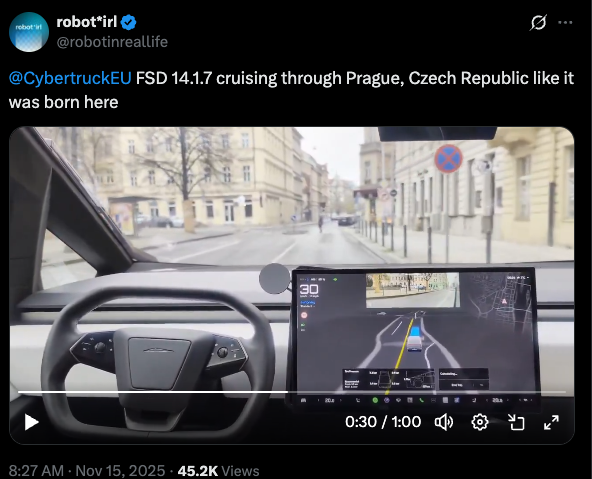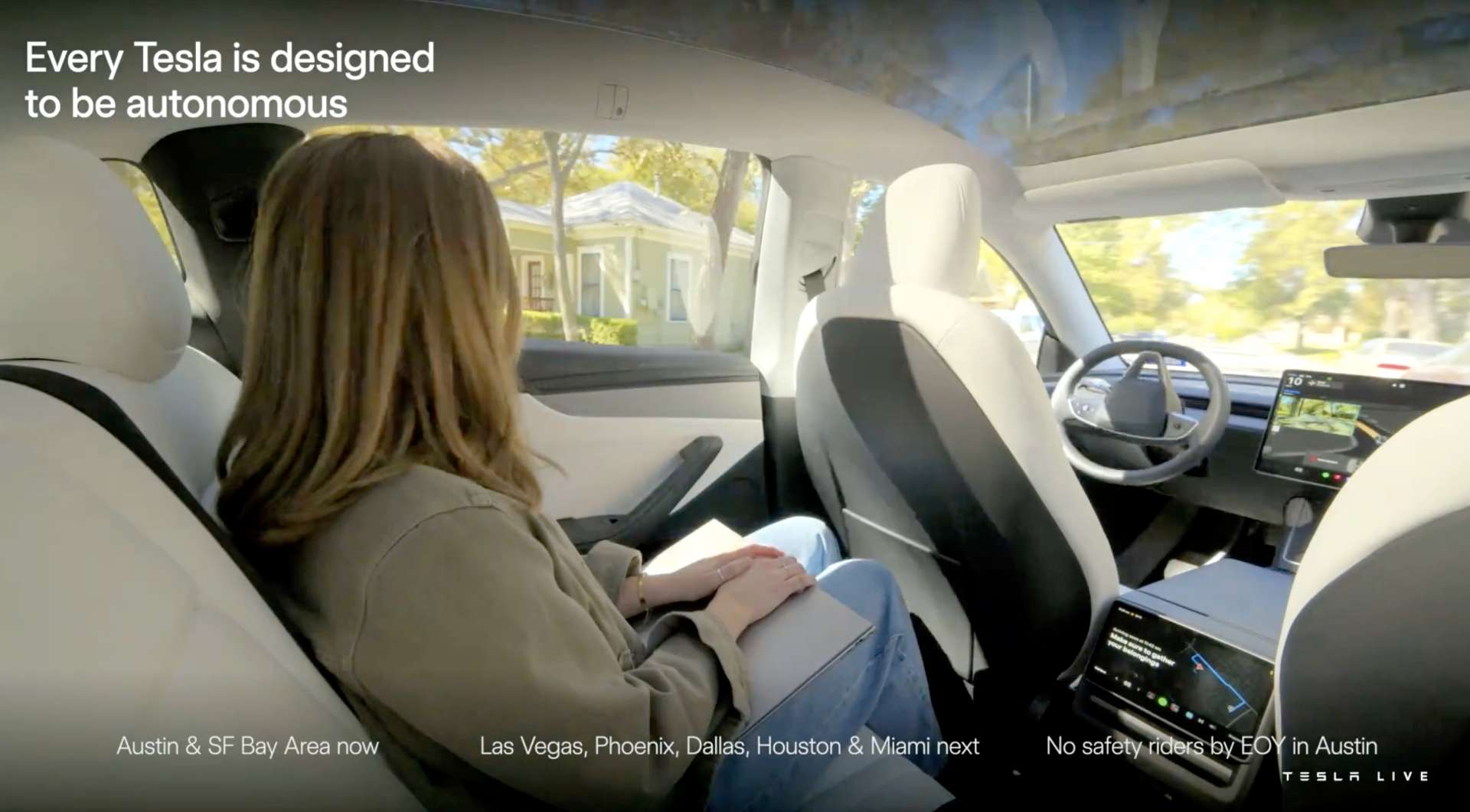Elon Musk has been very explicit in promising a robotaxi launch in Austin in June with unsupervised full self-driving (FSD). We'll give him some leeway on the timing and say this counts as a YES if it happens by the end of August.
As of April 2025, Tesla seems to be testing this with employees and with supervised FSD and doubling down on the public Austin launch.
PS: A big monkey wrench no one anticipated when we created this market is how to treat the passenger-seat safety monitors. See FAQ9 for how we're trying to handle that in a principled way. Tesla is very polarizing and I know it's "obvious" to one side that safety monitors = "supervised" and that it's equally obvious to the other side that the driver's seat being empty is what matters. I can't emphasize enough how not obvious any of this is. At least so far, speaking now in August 2025.
FAQ
1. Does it have to be a public launch?
Yes, but we won't quibble about waitlists. As long as even 10 non-handpicked members of the public have used the service by the end of August, that's a YES. Also if there's a waitlist, anyone has to be able to get on it and there has to be intent to scale up. In other words, Tesla robotaxis have to be actually becoming a thing, with summer 2025 as when it started.
If it's invite-only and Tesla is hand-picking people, that's not a public launch. If it's viral-style invites with exponential growth from the start, that's likely to be within the spirit of a public launch.
A potential litmus test is whether serious journalists and Tesla haters end up able to try the service.
UPDATE: We're deeming this to be satisfied.
2. What if there's a human backup driver in the driver's seat?
This importantly does not count. That's supervised FSD.
3. But what if the backup driver never actually intervenes?
Compare to Waymo, which goes millions of miles between [injury-causing] incidents. If there's a backup driver we're going to presume that it's because interventions are still needed, even if rarely.
4. What if it's only available for certain fixed routes?
That would resolve NO. It has to be available on unrestricted public roads [restrictions like no highways is ok] and you have to be able to choose an arbitrary destination. I.e., it has to count as a taxi service.
5. What if it's only available in a certain neighborhood?
This we'll allow. It just has to be a big enough neighborhood that it makes sense to use a taxi. Basically anything that isn't a drastic restriction of the environment.
6. What if they drop the robotaxi part but roll out unsupervised FSD to Tesla owners?
This is unlikely but if this were level 4+ autonomy where you could send your car by itself to pick up a friend, we'd call that a YES per the spirit of the question.
7. What about level 3 autonomy?
Level 3 means you don't have to actively supervise the driving (like you can read a book in the driver's seat) as long as you're available to immediately take over when the car beeps at you. This would be tantalizingly close and a very big deal but is ultimately a NO. My reason to be picky about this is that a big part of the spirit of the question is whether Tesla will catch up to Waymo, technologically if not in scale at first.
8. What about tele-operation?
The short answer is that that's not level 4 autonomy so that would resolve NO for this market. This is a common misconception about Waymo's phone-a-human feature. It's not remotely (ha) like a human with a VR headset steering and braking. If that ever happened it would count as a disengagement and have to be reported. See Waymo's blog post with examples and screencaps of the cars needing remote assistance.
To get technical about the boundary between a remote human giving guidance to the car vs remotely operating it, grep "remote assistance" in Waymo's advice letter filed with the California Public Utilities Commission last month. Excerpt:
The Waymo AV [autonomous vehicle] sometimes reaches out to Waymo Remote Assistance for additional information to contextualize its environment. The Waymo Remote Assistance team supports the Waymo AV with information and suggestions [...] Assistance is designed to be provided quickly - in a mater of seconds - to help get the Waymo AV on its way with minimal delay. For a majority of requests that the Waymo AV makes during everyday driving, the Waymo AV is able to proceed driving autonomously on its own. In very limited circumstances such as to facilitate movement of the AV out of a freeway lane onto an adjacent shoulder, if possible, our Event Response agents are able to remotely move the Waymo AV under strict parameters, including at a very low speed over a very short distance.
Tentatively, Tesla needs to meet the bar for autonomy that Waymo has set. But if there are edge cases where Tesla is close enough in spirit, we can debate that in the comments.
9. What about human safety monitors in the passenger seat?
Oh geez, it's like Elon Musk is trolling us to maximize the ambiguity of these market resolutions. Tentatively (we'll keep discussing in the comments) my verdict on this question depends on whether the human safety monitor has to be eyes-on-the-road the whole time with their finger on a kill switch or emergency brake. If so, I believe that's still level 2 autonomy. Or sub-4 in any case.
See also FAQ3 for why this matters even if a kill switch is never actually used. We need there not only to be no actual disengagements but no counterfactual disengagements. Like imagine that these robotaxis would totally mow down a kid who ran into the road. That would mean a safety monitor with an emergency brake is necessary, even if no kids happen to jump in front of any robotaxis before this market closes. Waymo, per the definition of level 4 autonomy, does not have that kind of supervised self-driving.
10. Will we ultimately trust Tesla if it reports it's genuinely level 4?
I want to avoid this since I don't think Tesla has exactly earned our trust on this. I believe the truth will come out if we wait long enough, so that's what I'll be inclined to do. If the truth seems impossible for us to ascertain, we can consider resolve-to-PROB.
11. Will we trust government certification that it's level 4?
Yes, I think this is the right standard. Elon Musk said on 2025-07-09 that Tesla was waiting on regulatory approval for robotaxis in California and expected to launch in the Bay Area "in a month or two". I'm not sure what such approval implies about autonomy level but I expect it to be evidence in favor. (And if it starts to look like Musk was bullshitting, that would be evidence against.)
12. What if it's still ambiguous on August 31?
Then we'll extend the market close. The deadline for Tesla to meet the criteria for a launch is August 31 regardless. We just may need more time to determine, in retrospect, whether it counted by then. I suspect that with enough hindsight the ambiguity will resolve. Note in particular FAQ1 which says that Tesla robotaxis have to be becoming a thing (what "a thing" is is TBD but something about ubiquity and availability) with summer 2025 as when it started. Basically, we may need to look back on summer 2025 and decide whether that was a controlled demo, done before they actually had level 4 autonomy, or whether they had it and just were scaling up slowing and cautiously at first.
13. If safety monitors are still present, say, a year later, is there any way for this to resolve YES?
No, that's well past the point of presuming that Tesla had not achieved level 4 autonomy in summer 2025.
14. What if they ditch the safety monitors after August 31st but tele-operation is still a question mark?
We'll also need transparency about tele-operation and disengagements. If that doesn't happen soon after August 31 (definition of "soon" to be determined) then that too is a presumed NO.
Ask more clarifying questions! I'll be super transparent about my thinking and will make sure the resolution is fair if I have a conflict of interest due to my position in this market.
[Ignore any auto-generated clarifications below this line. I'll add to the FAQ as needed.]
Update 2025-11-01 (PST) (AI summary of creator comment): The creator is [tentatively] proposing a new necessary condition for YES resolution: the graph of driver-out miles (miles without a safety driver in the driver's seat) should go roughly exponential in the year following the initial launch. If the graph is flat or going down (as it may have done in October 2025), that would be a sufficient condition for NO resolution.
Update 2025-11-06 (PST) (AI summary of creator comment): The creator outlined how they would update their probability assessment based on three possible scenarios by January 1st:
World 1: Tesla misses deadline, safety riders still present, no expansion → probability should drop
World 2: Tesla technically hits deadline with some confirmed rides without safety riders, but no scaling up → creator would be suspicious this is a publicity stunt/controlled demo rather than meaningful evidence of level 4 autonomy
World 3: Safety riders gone in Austin plus meaningful expansion → would be a meaningful update on probability Tesla has cracked level 4 autonomy
Note: All three scenarios would still leave question marks about whether Tesla achieved level 4 by the August 31, 2025 deadline.
People are also trading
An unofficial tracker (of people counting license plates!) puts the number of Robotaxi in Austin to 29 https://x.com/ethanmckanna/status/1992408024804434281
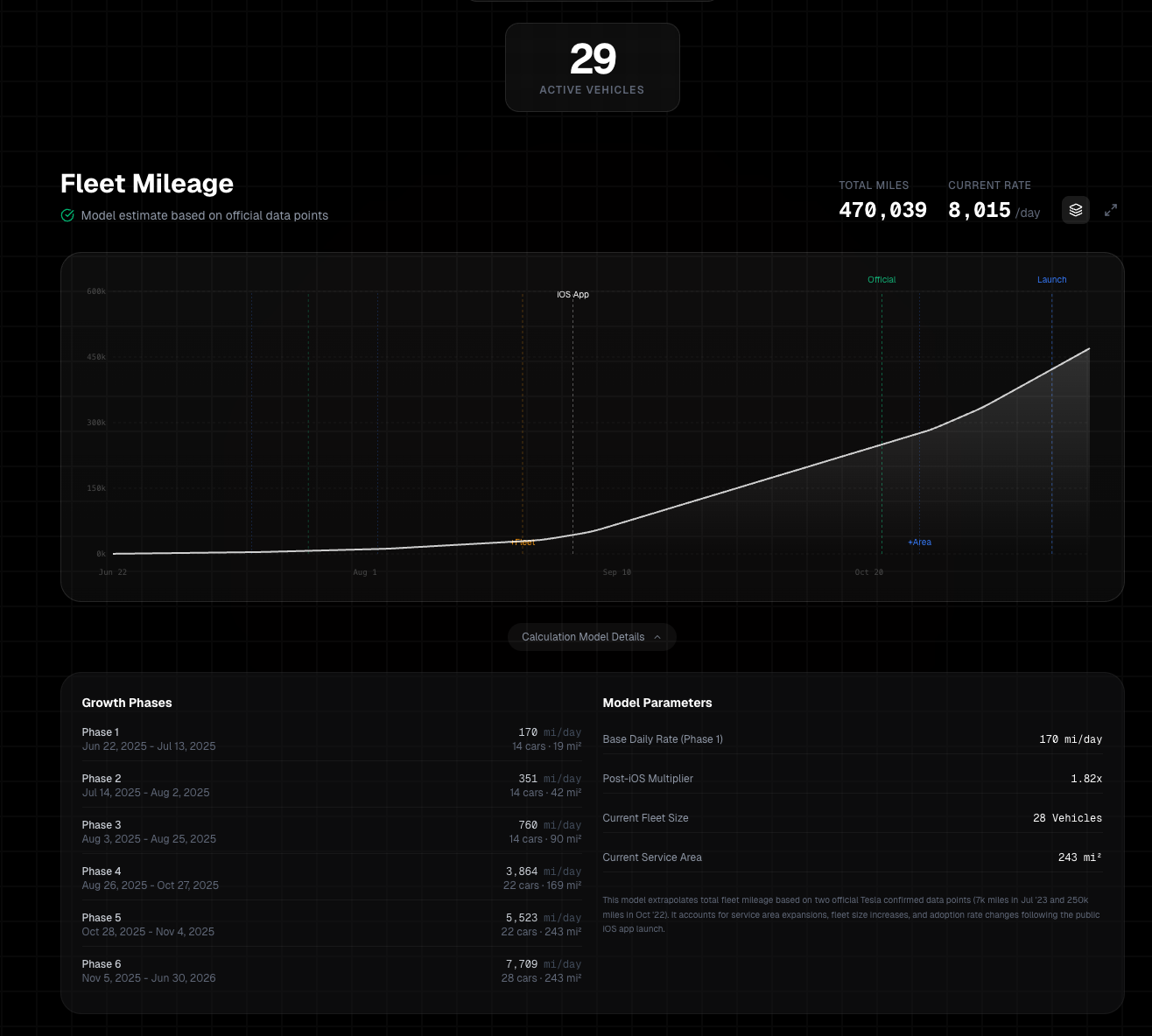
Waymo count: 92 https://waymo.watch/
@MarkosGiannopoulos Looks like waymo.watch shows zero for multiple cities they've launched in. We do know there are over 100 Waymos in Austin, but maybe not a lot more? Here's what Claude 4.5 Opus thinks:
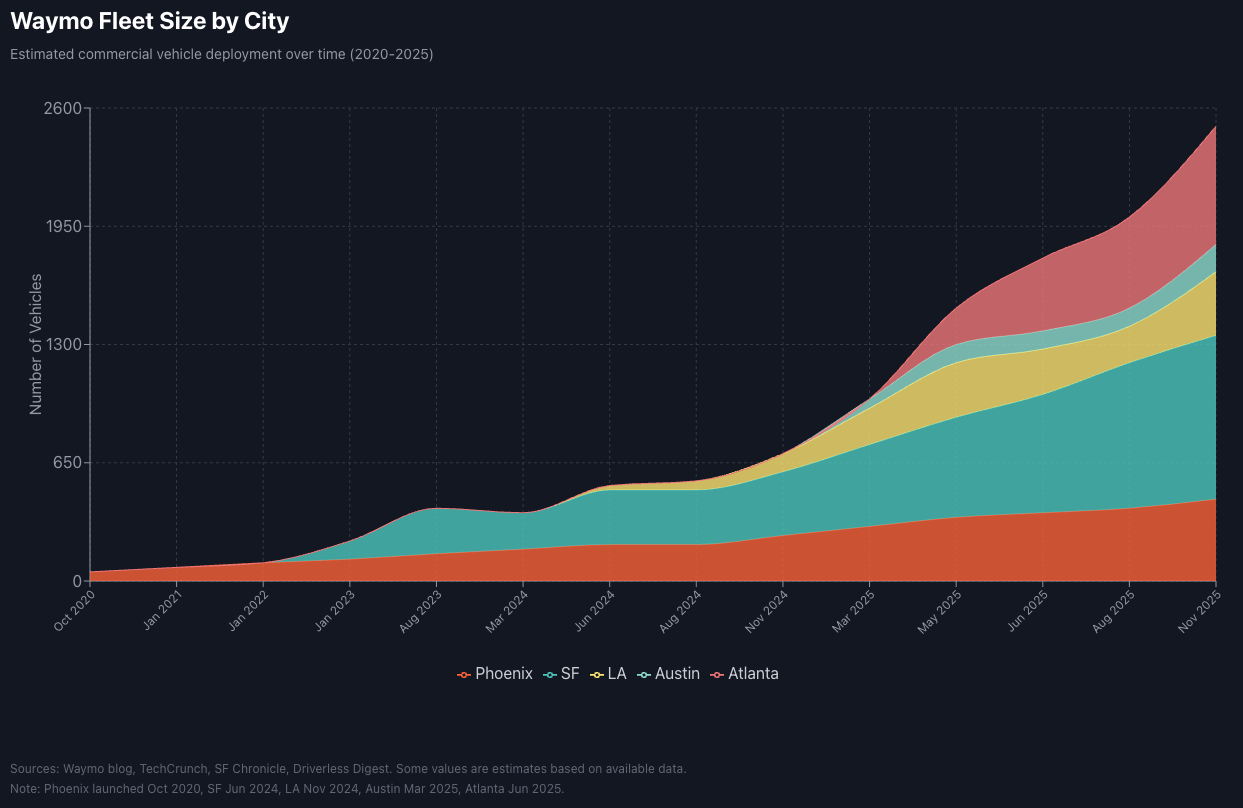
FSD handling Canadian snow https://x.com/SawyerMerritt/status/1988056514511380540
Seems like Tesla is ahead of Waymo on some parts of this autonomy thing.
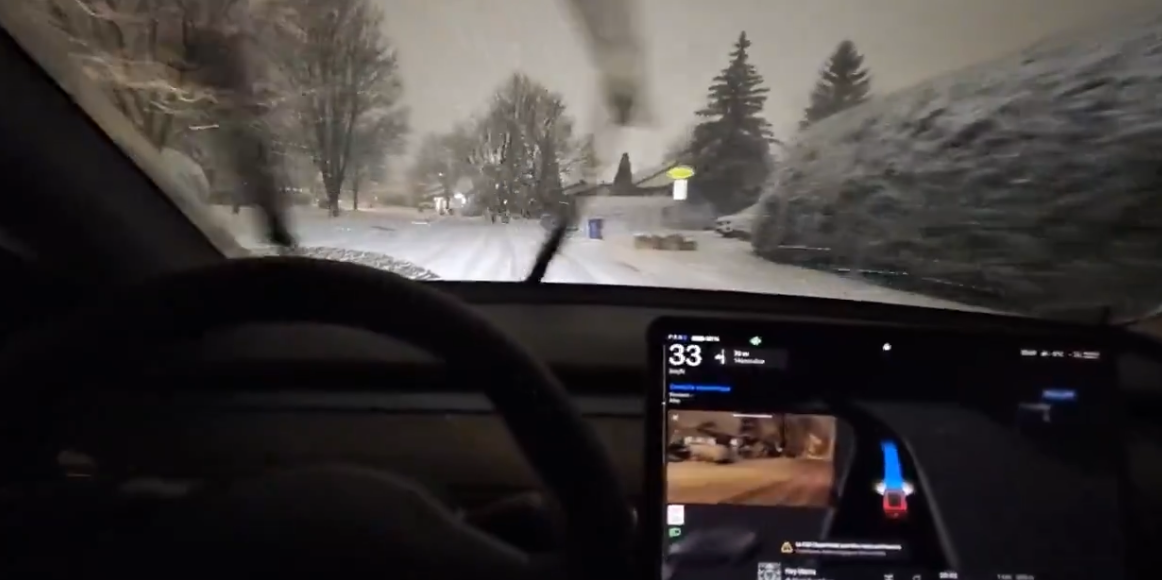
@dreev Is that already available with questions like:
https://manifold.markets/GabeGarboden/will-tesla-offer-a-robotaxi-service
https://manifold.markets/aashiq/will-tesla-have-driverless-ridehail
Edit to add
https://manifold.markets/513ws/tesla-launches-unsupervised-fsd-ser
https://manifold.markets/RyanandPickles/will-tesla-release-a-full-level-4-a
@ChristopherRandles Ah, thank you, yes, those are pretty close! Still wouldn't hurt to have one for this exact question, of course.
I'm also interested to hear how people will update in the possible worlds we could be in on January 1st:
Tesla misses the deadline, safety riders are still in place and no big expansion of rides with an empty driver's seat (with or without a passenger-seat monitor)
Tesla technically hits the deadline, we get confirmation of some rides with no safety rider, but no scaling up
Safety riders all gone in Austin, plus meaningful expansion.
I would say the probability for this market should drop in world 1. In world 2 I'd be suspicious that it's more a publicity stunt and controlled demo than a meaningful update on the probability that Tesla has cracked level 4 autonomy. World 3 of course would be such an update.
(Again, all of those would still leave medium to huge question marks about the specific question this market has asked, about whether Tesla was level 4 by August 31, 2025.)
@dreev Yesterday they also made more clear the production start for Cybercab, from "Q2 2026" to "April 2026". Seems like a very expensive "publicity stunt" to show off building a car without a steering wheel :)
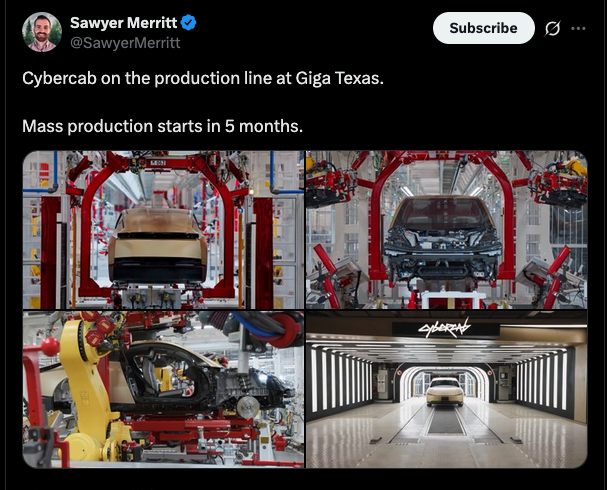
@MarkosGiannopoulos Partial/potential counterpoint: https://www.notateslaapp.com/news/3278/teslas-plan-b-for-cybercab-add-steering-wheel-and-pedals-if-required
@dreev Sure, they have a backup plan to include a steering wheel for legal purposes. That does not mean they plan to have drivers/safety monitors in it. Cybercab seats two people. It would not be very smart to try to have a taxi service seating just one person at a time.
From comment in above question
https://firebasestorage.googleapis.com/v0/b/mantic-markets.appspot.com/o/user-images%2Fdefault%2F099d8LAE0N.png?alt=media&token=9c2c827e-830b-4160-bace-0579c0a9efd2
Chat GPT saying new licence needed in Texas for driverless.
They also haven't even applied in California, Nevada or Arizona yet AFAIK.
I am wondering if getting the first such licence and operating in such a manner should be seen as more of a launch date for level 4 robotaxis than the supervised testing that started Aug? There is possibility that Florida or somewhere has less regulated approach and it happens there first, so maybe such licencing isn't strictly necessary. However this seems more objective than a subjective when do you view the service as first launched.
V14 does seem to be showing itself to be better than v13, with 3309 miles without critical DE on the tracker app compared to 644 at most under v13. This is encouraging. If applications for licencing go in using v14 which was in use in August and are approved then there seems more of an argument that you can trace use of the system back to August. If Tesla gets to v15 before submitting applications for licences or removing all safety monitors then that tracing back to August 2025 seems much harder to argue.
To me, "launched level 4 robotaxis" should mean that if there is a safety monitor then it isn't level 4 and this question should resolve no as level 4 didn't start by Aug 2025.
An alternative of if unsupervised happens with v14 which was in use in August 2025 on the taxis then maybe you can say it launched summer 2025 with cautious supervision which wasn't really necessary. This seems a bit subjective to me as to when it launched.
@ChristopherRandles On the last point, it has been mentioned multiple times (by Musk but also Tesla engineers) that Robotaxi in Austin was running an early version of v14 before it was released to the public.
@MarkosGiannopoulos Maybe it was unclear but by "with v14 which was in use in August 2025" I was trying indicate that yes, the pseudo-robotaxis were using v14 in June. The 'if' part of these two sentences were about if licence applications went in using v14 and if unsupervised happens with v14. Neither of these two parts have happened yet to my knowledge.
If "launched summer 2025 with cautious supervision which wasn't really necessary" you would expect it to happen soon unless this is held back by regulation. If it is only regulation that is holding it back then you would expect the licence applications to go in as soon as Tesla possible can do so. At some point there has to be enough delay that we conclude that no Tesla was not ready to launch level 4. How much time that needs to be seems rather subjective and a preference for something more objective seems sensible.
@dreev >"I'm also interested to hear how people will update in the possible worlds we could be in on January 1st:
Tesla misses the deadline, safety riders are still in place and no big expansion of rides with an empty driver's seat (with or without a passenger-seat monitor)
Tesla technically hits the deadline, we get confirmation of some rides with no safety rider, but no scaling up
Safety riders all gone in Austin, plus meaningful expansion."
Are these different worlds or merely different timescales to the point where there is no monitors and expansion? A big "break" before the level is reached where monitors can be removed might make the launch seem to be after the "break". By "break" should we be defining some period of time? Is it more appropriate to look at events for when launch or "break" happened? e.g. monitors actually removed? Start of use of version that is first used without monitors?
@ChristopherRandles They do blend into each other. But consider the possible snapshots we may see on January 1st. I'm thinking the probability for this market goes down in case 1 (maybe gradually as we approach and go past January 1), stays about the same in case 2, and goes up in case 3.
@dreev I don't see any reason to doubt that it is logical that the more time passes before monitor removal and scaling up the more it seems like a no (unless it is already 100% no which seems quite plausible to me as with a monitor they are not level 4 so not launched yet).
Technically hits deadline i.e. first driverless rides on 31 Dec 2025 but no scaling up well I want to know a) is that no scaling up until 10 Jan or 31 Mar or 30 Jun? and if we don't want to wait to find out then b) what is(seems to be) reason for no scaling up?
How much time before you decide it is a no seems like a how long is a piece of string question. It can be whatever you want and seems a poor way of deciding the question.
Should it go up in case 3? Well I am not sure. If it happened tomorrow while still on v14 then I would expect the price at which it trades to go up even if I am reluctant to accept that it should. If they announce v15 by 20 Dec and immediately start removing monitors and scaling up, with v15 only, then I think it should go down, they clearly weren't truly ready for driverless in August.
i.e. I am saying look at events not how long before we think they weren't really ready in August. While the event I prefer is 'when are they level 4 robotaxis?' but I can perhaps see a case for 'when did they first use with the public on board the version of software that is first used for fully driverless taxis?'.
Going from
We need there not only to be no actual disengagements but no counterfactual disengagements. and 3 or 4 accidents and reports of erratic driving
to
Ahh well lets just disregard that and if I feel like the launch was June even if it wasn't level 4 at that time I am going to go with this feeling.
seems inappropriate.
If the miles on the tracker keep accumulating with no critical disengagements such that it looks like the accidents were minor bugs that were quickly fixed then perhaps it is a bit less clear cut. Waiting for events like when are safety monitors removed, version changes and lots more miles on the tracker seems more defensible than how much time should be allowed before we rule out a yes resolution.
Yeah, to be clear, the whole reason we're waiting so long to resolve is because we're hoping for some real evidence. I think we're mostly on the same page about how to consider the question. A possible quibble is that the version numbers of FSD may not mean much. Like suppose Tesla has their level 4 autonomy breakthrough early next year. Maybe they call it FSD 14.12.0 instead of 15, precisely because calling it version 15 amounts to an admission that FSD 14 wasn't level 4. Maybe that's not actually likely.
@dreev @ChristopherRandles The current Musk-estimation is for v14.3: "I think by 14.3 is where you can just, pretty much fall asleep and wake up at your destination" https://x.com/XFreeze/status/1986611664100450784
@ChristopherRandles On the Robotaxi-version of FSD, Musk has said that they were/are using early versions of it. While customers had v13 during the summer, the Austin cars were already on an alpha/beta of v14.
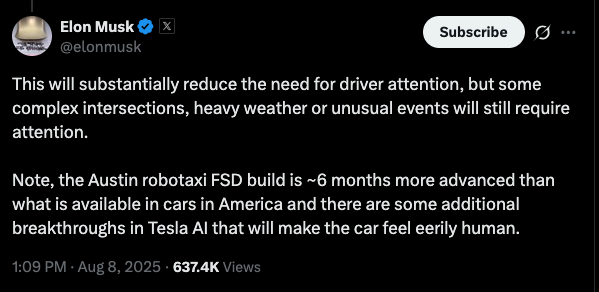
@ChristopherRandles So someone without any prior history on the platform just happened to have a critical disengagement in their first 50 miles? Interesting :)
